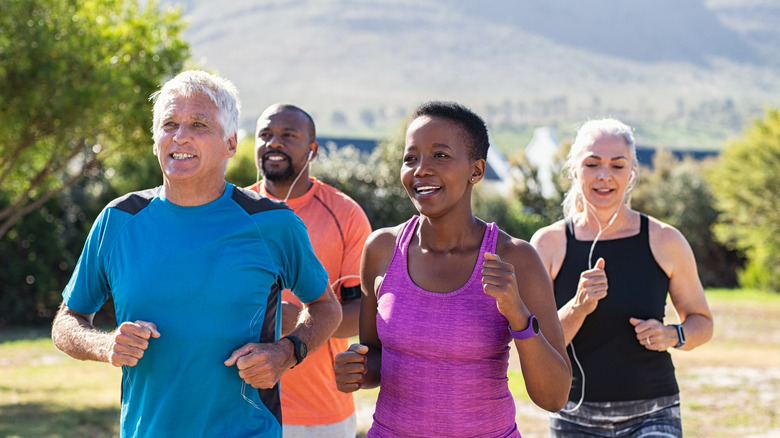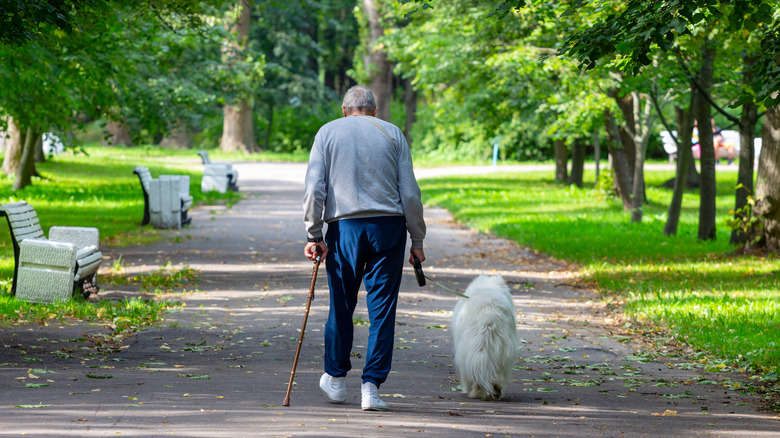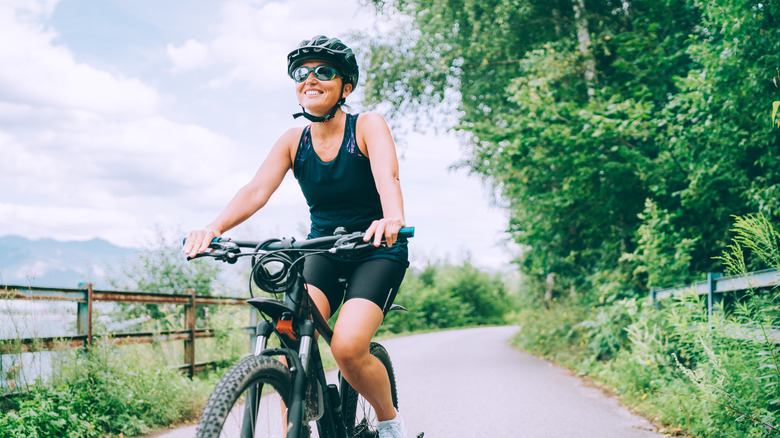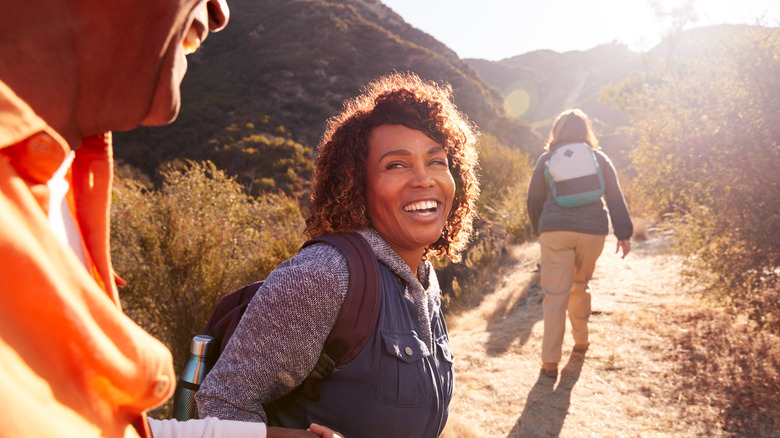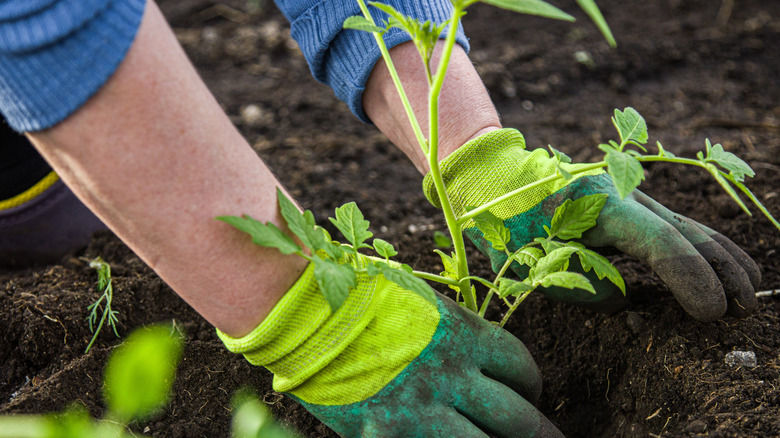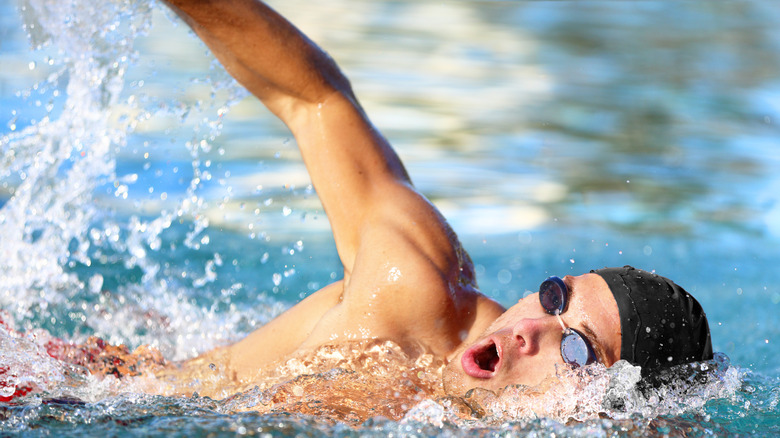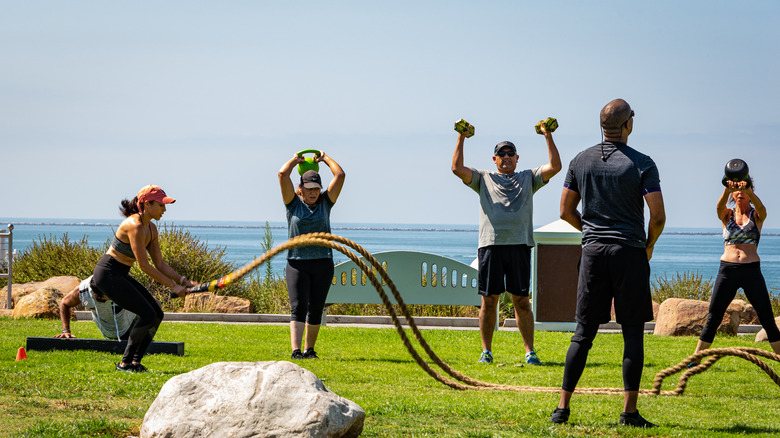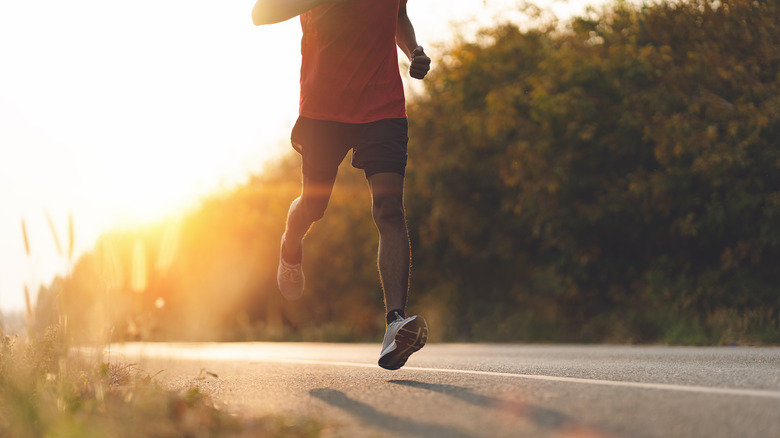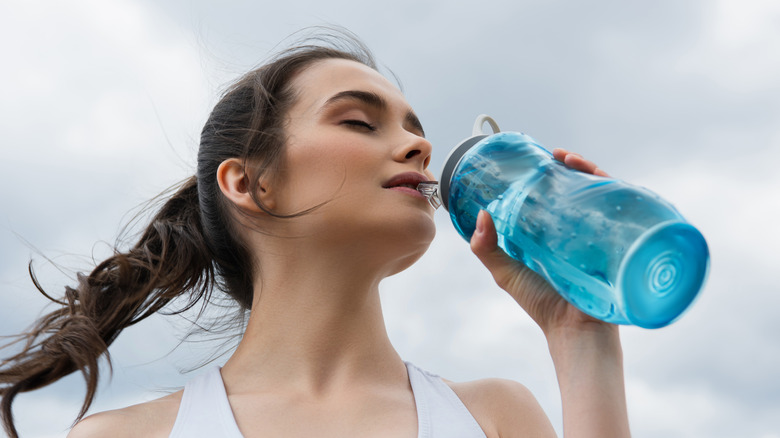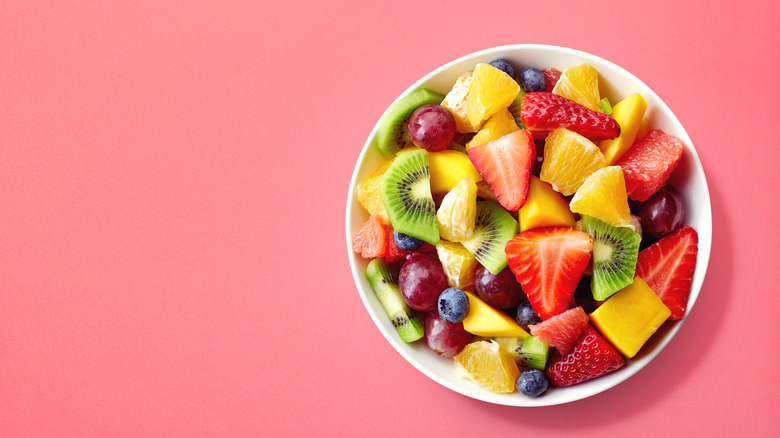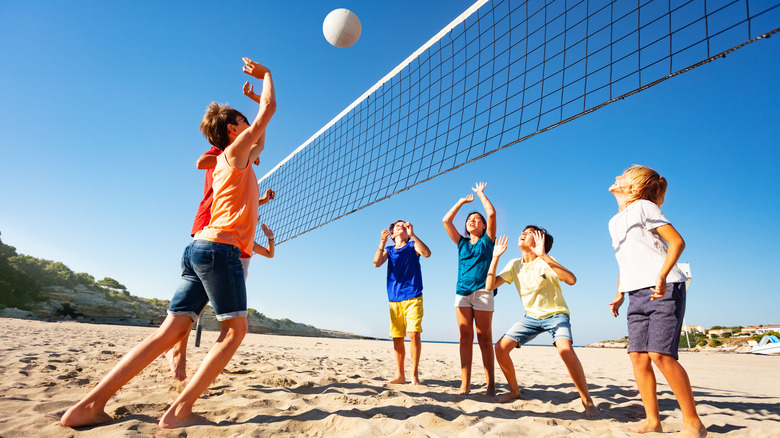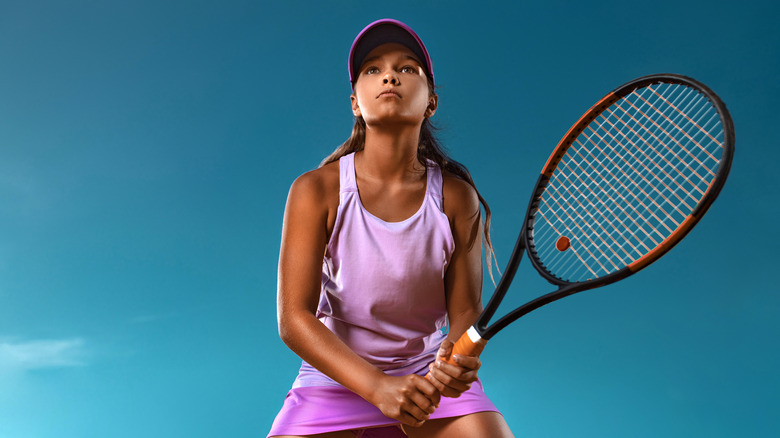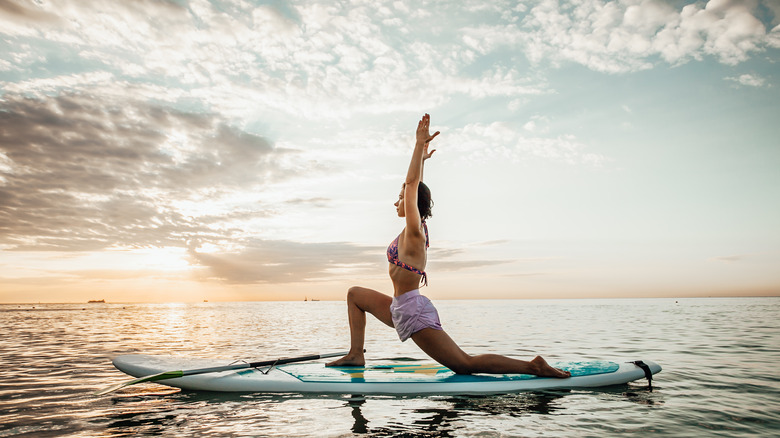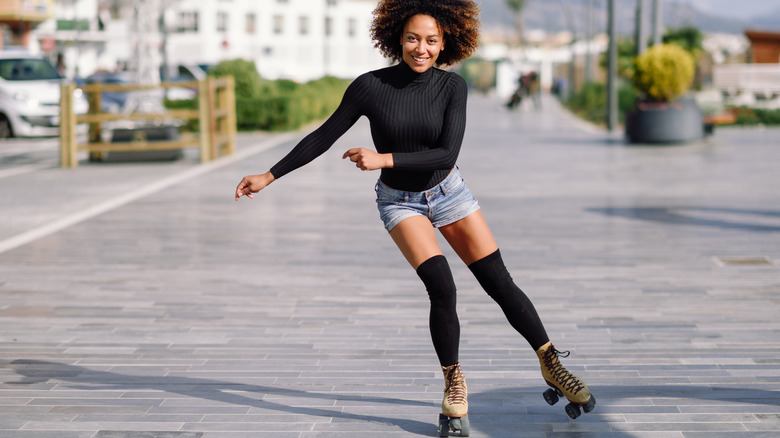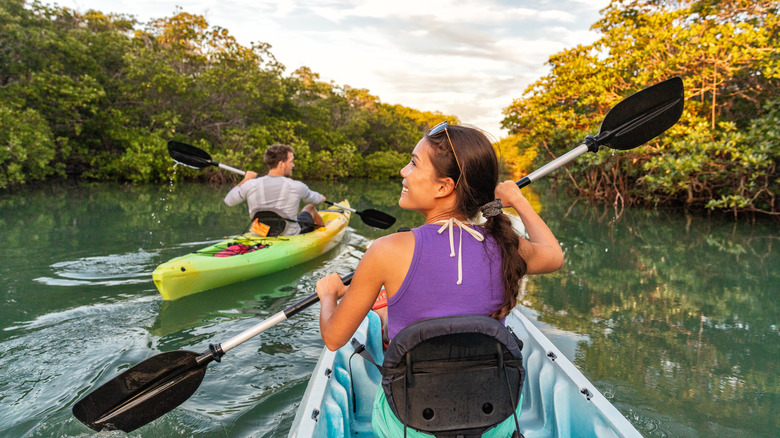The 14 Best Ways To Stay Fit During The Summer
Even if it's not summer, it's perfectly acceptable to dream ahead to those warm, balmy months when the days seem to stretch on endlessly (in the best way). After a cold winter and a potentially wet spring, the arrival of summer can feel like a massive relief. It's the perfect time to take whatever activities you were doing indoors and move them outside for fresh air. Whether it's working out, cooking, socializing, or just relaxing, summer provides the perfect backdrop for almost any activity. For those who may use cool weather as an excuse not to work out, summer nips all of that in the bud. Walking the dog, going for a hike, and taking a swim can all be done in the warmer months without hesitation.
Furthermore, longer stretches of daylight make it even easier to squeeze in those extra few hours of gardening or that jog around the block. According to Medical News Today, the perks of physical activity include improving mental health, preventing obesity, preventing certain cancers, improving heart health, and improving sleep. With so many benefits to moving your body, there really isn't any excuse not to get to it. If you need some inspiration on how to get and stay fit this summer, continue reading.
Walking
Going outside for a walk in the summer can be both relaxing and invigorating. Healthline explains that walking is a physical activity that is appropriate and beneficial for people at any age and any fitness level, and provides a wealth of health benefits. Furthermore, it's one of the easier activities to integrate into your daily routine, even if you find yourself with a packed schedule. For starters, the site explains that if you're looking to manage your weight or lose some, walking will burn calories. Several factors may influence how many calories you burn in a single walk, such as how fast you're walking, how long you've walked, and where you're walking (whether it's uphill, for example).
Furthermore, the site explains that just 30 minutes of walking a day has been proven to help reduce the risk of heart disease by almost 20%, and that this percentage can increase if you walk more. If you're feeling that mid-day slump, going for a walk may actually be more effective at boosting your energy than a cup of coffee. This is thanks to the fact that walking increases the oxygen flow in your blood, as well as increases levels of certain hormones that help regulate your energy.
Riding your bike
If you haven't hopped on your bike since your childhood days, it may be time to revisit this fun activity. Riding your bike is an aerobic exercise that is low impact, and is also great for people of all fitness levels, according to Healthline. Similar to walking, cycling is a great activity for those who are looking to either lose weight or help manage it. Depending on your level of fitness and the level of intensity at which you are cycling, you can burn about 370 calories in a 30-minute session (via Healthline). Additionally, riding your bike can help strengthen your leg muscles without putting the additional pressure on your joints that can come from jogging or running. Healthline explains that the quads, glutes, hamstrings, and calves are all targeted when you ride your bike.
If you are feeling stressed out or lack focus in your daily life, cycling has been proven to help with both. The site explains that by directing all of your attention to the road, you can shift your focus away from whatever is bothering you and focus on the present moment. One particular study published by PLoS One proved this theory and found that daily cycling for at least 30 minutes improved cognitive function in a group of older adults.
Hiking
Spending time in the great outdoors is beneficial for both the body and mind (via the American Psychological Association). The combination of getting in cardio mixed with the proven calming effects of nature can support our mental and physical health in numerous ways. WebMD affirms this idea, and says that hiking can be a "powerful cardio workout" that is known to lower the risk of heart disease, improve blood pressure, improve bone density, strengthen your core, and help you lose weight among other benefits. While hiking is another activity that is good for people of all ages and fitness levels, the site suggests starting slow if you are new to hiking. Shorter and more local hikes may be easier for beginners to manage. Once you've gotten some practice in, you can graduate to hikes on more uneven terrain, which offer more resistance.
If you want to strengthen your upper body, WebMD recommends using hiking poles, explaining that when you dig into the ground you are actually "propelling" yourself forward and engaging your arms. If you're looking to burn more calories, the site suggests finding a hill to hike on, as increasing the incline by as little as 5% can help you burn as much as 30-40% more calories.
Gardening
Having a green thumb could be a major advantage to you in the summer months if you're trying to get fit. While some may scoff at the idea of gardening being enough physical activity to get you in shape, experts at MindBodyGreen beg to differ, calling gardening the "ultimate mind-body workout." The site explains that the American Heart Association has officially labeled gardening as a "moderate workout," and it can even veer into the category of "vigorous intensity aerobic activity" if you are doing consistent work such as digging or hoeing. What's more, MindBodyGreen says a session of gardening may even net you as many calories burned as going to the gym.
Additionally, a study conducted by the University of Arkansas found that women over the age of 50 who gardened at least once a week had higher bone density than those who practiced other forms of exercise such as jogging or walking. Gary L. Altman, associate director of the Horticultural Therapy Program at Rutgers University School of Environmental and Biological Sciences, spoke to MindBodyGreen and extolled the benefits of gardening as a full-body exercise: "[It] works all of the major muscle groups including legs, buttocks, back, abdomen, neck, arms, and shoulders."
Swimming
A refreshing dip in the pool in the hot summer months could turn into serious aerobic exercise if you are committed to getting fit. Swimming is another great low-impact activity that can work your whole body, and is good for all fitness levels according to Healthline. The site explains that when compared to an hour of running, an hour of swimming burns almost as many calories. Like gardening, swimming is a full-body workout, increasing your heart rate, toning your muscles, building strength, and increasing endurance.
If you want to target different muscle groups, certain swimming strokes can help you do that. Strokes such as the breaststroke, backstroke, and the butterfly work your body in different ways, and incorporating them all into your routine can give you a well-rounded workout. It's also an excellent cardiovascular workout, and can improve the functioning of both your heart and lungs, according to the site. The Centers for Disease Control and Prevention (CDC) has gone so far as to say that those who take up swimming reduce their chance of death by 50% compared to those who are inactive. Swimming can also greatly benefit people who have arthritis, osteoporosis, or other injuries that affect their joints because the sport is so low-impact.
Outdoor boot camp
If you are really committed to your summer fitness goals, an outdoor boot camp may be right up your alley. According to Mayo Clinic, a boot camp is described as a high-intensity workout that combines aerobics and strength training in a single class via bodyweight exercises. Bodyweight exercises, also known as calisthenics, are what you might commonly associate with military-style drills: pushups, squats, lunges, and the like. The site explains that boot camps are essentially a high intensity interval training (HIIT) workout, which incorporates the aforementioned exercises in bursts, balancing them with lower intensity exercises to help build endurance. These types of workouts also focus on the whole body, and provide many of the same benefits of regular workouts in a more concentrated amount of time.
As the Mayo Clinic explains, boot camps will be harder for those who are not already somewhat in shape, as they require "ballistic, rapid movements" that can be challenging. Furthermore, if you are over the age of 40, pregnant, or just haven't hit the gym in a while, experts recommend consulting your doctor before signing up for boot camp. Additional benefits of boot camp include burning a considerable number of calories when compared to lower intensity workouts, increasing your metabolism, and gaining muscle mass.
Running
Stepping outside for a run during the summer months is another great way to stay in shape and take advantage of the ideal weather conditions. Running is both free and convenient, and novices and experts alike can reap its benefits. If you are someone who's always wanted to run but just hasn't gathered the courage to start, the experts say you're not alone. Peloton tread instructor Jess Sims spoke to Women's Health and explained, "I think people have a love-hate relationship with running because it can be intimidating to start. And to that I say, just start! Take some pressure off yourself." If you're new to running, Sims suggests starting off by alternating running for two minutes with walking. You can also start by just running for a couple times a week, then slowly increasing it.
According to WebMD, one of the benefits of creating a regular running habit includes improving your cardiovascular health. The site explains that a minimum of 10 minutes of running daily has been shown to decrease your risk of heart disease and cut your risk of dying by 50%. Experts at the site say that it also lowers your resting heart rate, and can lead to improved sleep.
Stay hydrated
All of this exercising is great, but while you're moving in the hot summer temperatures, it's important to remember to drink water to not undo all of the benefits you've been amassing. Verywell Fit experts explain that because our bodies sweat more in hot weather in order to help cool down, it's necessary for us to replenish those lost fluids by drinking more water. Exercising in hot weather only increases the amount of fluids lost, which makes it doubly important to stay on top of your hydration.
Signs of dehydration include the somewhat obvious feeling of thirst, as well as a "dry or sticky" mouth according to the site. Signs further down the line may include fatigue, urinating less frequently, or darker colored urine. The site recommends hydrating before exercising, and making sure to keep a water bottle close by so there is no excuse not to take a sip. If you are exercising a lot, it's also recommended to consume beverages that contain electrolytes to help improve the absorption of your water. Lastly, make sure to drink water when you are finished exercising.
Eat seasonal fruit
Another exciting benefit of the hot summer months is the cornucopia of fresh, seasonal fruit that becomes available. While of course you can find delicious fruit year-round, certain fruits are that much more delicious when they are fresh and harvested in season (via The Spruce Eats). Experts at WebMD explain that fruits such as apricots, cantaloupe, cherries, and peaches are popular summer fruits that are rich in vitamins, minerals, and antioxidants. One fruit you'll be sure to find a lot of during the summer months are berries. Nutritional experts at the site explain that just one cup of blueberries serves up 4 grams of fiber and 32% of the recommended daily allowance of vitamin C. Strawberries are another fruit you are no doubt accustomed to seeing during the summer months that are an abundant source of vitamin C, as well as the antioxidant ellagic acid, and anthocyanosides and catechins, which fight cancer. Furthermore, if you're looking to stay hydrated, why not eat your water? Watermelon is another classic summer fruit that contains a half a cup of water per one cup serving, according to Healthline. Cantaloupe also makes the list of hydrating summer fruits, containing 90% water, or a little over half a cup per serving.
Beach volleyball
If you find yourself by a patch of sand during the summer months, hopping in a game of beach volleyball can be a fun and social way to squeeze in a workout. Livestrong experts explain that playing volleyball is not only a good way to get fit, it's also a good bonding activity between friends. Another Livestrong article that focuses on the health benefits of the sport explains that for those looking to lose weight, a 45-minute game of volleyball can burn as many as 585 calories. If you commit to playing regularly, volleyball could contribute to weight loss.
Furthermore, with all of the spikes and serves it requires, the sport helps to strengthen the arms and the shoulders. As you dart and dive around the court, your leg muscles also get a considerable workout, according to Livestrong. All that moving gets your cardiovascular and respiratory systems working, which contributes to an overall improvement in bodily functions and wellbeing. Another perhaps unexpected benefit of playing volleyball on the sand is the extra workout you receive due to the resistance the unstable surface provides. According to Healthline, this requires you to use muscles and ligaments that you wouldn't work on a flat, hard surface. On top of all of the physical benefits, in volleyball it's necessary to interact with your teammates, creating an opportunity for bonding and sportsmanship. Experts at Livestrong say this can contribute to even more feelings of wellbeing and happiness.
Tennis
Tennis is another great summer sport that requires agility, focus, and offers a full-body workout. Verywell Fit outlines the many benefits the sport offers, starting out by highlighting its contribution to cardiovascular health. The movements required by tennis, including jumping to hit the ball, running down the court, and running after balls, all get your heart pumping. As your heart rate increases, so does your breath, which helps to circulate more oxygen throughout your body, improving your overall heart health. As with many of the activities on this list, tennis is another great way to lose weight. How many calories you burn will depend on your weight and how intensely you're playing, but you can expect to burn at least a few hundred calories per hour played, according to the site.
For those who struggle with limited range of motion, tennis can help improve that. Because of all the stretching tennis requires as you reach to swat the ball, you are actively lubricating your joints and "strengthening your muscle tendons," according to the site. Tennis can also help those who need to improve their balance, as the movements — like swatting at the ball with your arm extended — challenge your body's equilibrium.
Stand up paddle yoga
While you may have heard of stand up paddle boarding (SUP), and you've most certainly heard of yoga, the two combined may be an entirely new concept. Perhaps unsurprisingly, Verywell Fit explains that the sport originated in Hawaii and was popularized in the rest of the United States around 2010. In order to do SUP yoga you'll need a paddle board and a body of water, which could even include a pool. Experts at the site explain that you'll have to paddle out until you're well away from possibly dangerous obstacles in or around the water, and you can begin your practice there.
Standing on the paddle board alone requires you to engage all of your core muscles at once — and performing yoga on this surface demands a significant amount of focus to hold the poses, which also strengthens your mind-body connection. Furthermore, Dani Schenone, a registered yoga instructor and Mindbody wellness expert, explained to Verywell Fit: "SUP yoga is also an excellent way to engage in neuromotor exercise, which increases one's balance, coordination, and proprioception. The rocky waters add an additional layer of complexity that challenges one's equilibrium, making it a great way to increase stability and movement efficiency."
Roller skating
Roller skating is another activity that you may have thought was lost in your childhood days of yore. However, this sport has reached a new level of popularity thanks to social media users, according to Healthline, and offers an excellent opportunity to get in shape in a number of ways. For starters, roller skating requires the use of key muscles in your hips and legs, including your "glutes, quads, hamstrings, and calves," says the site. When it comes to your glutes, because you are pushing with your legs a little bit to the side instead of straight back, you are giving your gluteus maximus a good workout. The gluteus medius is also getting a good workout as you push forward. The combined use and cooperation of these muscles helps reshape the hip muscles and improve overall balance.
If losing weight is on the agenda, Healthline explains that roller skating can actually be a "calorie scorcher," burning as many calories as you might during group cycling or a rowing session. Of course, the number of calories burned will depend on how vigorous your workout is, but someone weighing 160 pounds might potentially burn nearly 270 calories per half hour of skating.
Kayaking
Kayaking is another summer sport that puts you in direct contact with mother nature. It can be a relaxing sport that is doable for all ages and levels of fitness, and also gives your muscles a good workout, according to Verywell Fit. Additionally, it's a low-impact activity that is good for those who want to strength train without creating additional pressure on the joints. Los Angeles-based personal trainer Laura Flynn Endres spoke to the site and explained how kayaking is the perfect sport for those who want to include more cardio into their routines: "Kayaking, because it's a rhythmic exercise where you maintain a fairly steady pace, fits the bill nicely ... Maintaining a steady pace (or even alternating between slower and faster intervals) will get the heart pumping and make this a fantastic low-impact exercise option for improving heart health and burning fat." How fast you paddle is entirely up to you, but the more intensely you do, the more your heart rate will increase.
Because kayaking requires rowing, it works the whole upper body — but the core also receives a considerable workout due to the "back and forth" motion required to paddle, which engages the abdominals.

